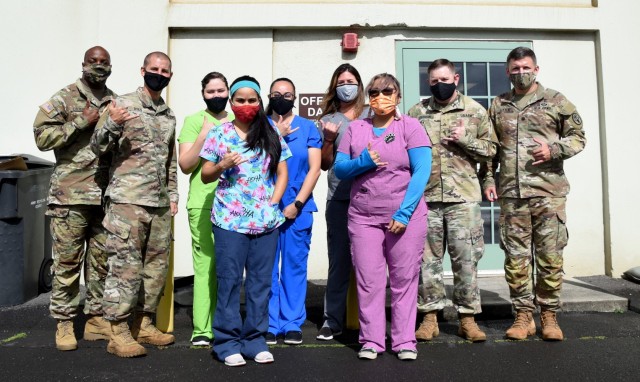FORT SHAFTER, Hawaii - Puppies with their people line up outside the veterinary activity here, ready for some extraordinary care. Thanks to the hard work of the Fort Shafter Veterinary Activity staff, the clinic recently attained American Animal Hospital Association accreditation, a feat accomplished by only 12 to 15 percent of clinics in the United States and Canada.
According to the AAHA, “The difference between ordinary and extraordinary” is what distinguishes an accredited veterinary practice from those that are not.
The effort was spearheaded by Dr. (Maj.) Mark A. Ryan, officer-in-charge of the Fort Shafter Veterinary Activity, but he insisted that his staff are the ones that spent months planning and preparing.
The accreditation process covers 19 functional areas, made up of 932 requirements, a monumental task that could only be effectively completed through teamwork and organization, according to Sgt. Clayton L. Gerrion, the clinic's animal care noncommissioned officer.
“I learned about it last November when Maj. Ryan explained what was going to happen, but I’m sure he had been thinking about it for a while,” said Gerrion.
The staff began its dedicated accreditation work in February, in addition to their regular mission, and continued until everything on the checklist was complete.
AAHA breaks the vast number of requirements down to 50 mandatory standards that include anesthesia, radiology, pain management, surgical rooms, and controlled substances. The rest of the requirements are point-based standards which cover quality of care, management, medical records, facility, and diagnostics and pharmacy.
The system is a catch-all that serves as an umbrella for a variety of possibilities. The accreditation process is adapted to fit the systems and equipment for each clinic.
Standard operating procedures were revamped throughout the clinic; signage was produced and placed accordingly, and new equipment was introduced.
Juliana Alvarez, an animal health technician at the clinic, enthusiastically explained the treatment offered at the clinic and how accreditation has enhanced the quality of services they provide.
“I had a good idea of what was going to happen, and it was very exciting,” she said. Alvarez learned about the importance of being accredited when she was earning her veterinarian technician degree in college.
Once Ryan introduced the topic, Alvarez said, the staff began doing self-assessments and later met as a group to discuss its plan for conquering the requirements.
“Maj. Ryan took our thoughts into consideration and that’s how we decided what each person was going to do,” said Alvarez, who concentrated on the patient care and surgery portions of the checklist.
Collectively, the staff reassessed the SOPs already in place and drafted new ones where required. It all translated into a better working environment which resulted in better service, staff members said.
As Gerrion walked through the radiology room, he explained how the accreditation has improved the service the clinic provides, as well as protecting the medical team delivering the care.
“We wear leather aprons, and if our hands are going to be near that area, we also wear gloves,” he said, "and anytime anyone is in here we wear dosimetry badges.”
The badges detect and measure the amount of radiation to which a person is exposed. The radiation measurements then become part of the individual’s medical records.
Although accreditation is not a requirement for clinic operation, it adds a level of prestige that makes a recognizable difference for the Soldiers, doctors, technicians, staff, and patients.
Lt. Col. Jered D. Little, commander of Public Health Activity – Hawaii, agreed.
“This team continues to show their commitment to patient and employee safety, and to the delivery of the highest standard veterinary care to our military community,” Little said.










Social Sharing